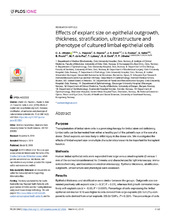| dc.contributor.author | Utheim, Øygunn Aass | en_US |
| dc.contributor.author | Pasovic, Lara | en_US |
| dc.contributor.author | Ræder, Sten | en_US |
| dc.contributor.author | Eidet, Jon Roger | en_US |
| dc.contributor.author | Fostad, Ida | en_US |
| dc.contributor.author | Sehic, Amer | en_US |
| dc.contributor.author | Roald, Borghild | en_US |
| dc.contributor.author | de la Paz, Maria Fideliz | en_US |
| dc.contributor.author | Lyberg, Torstein | en_US |
| dc.contributor.author | Dartt, Darlene A. | en_US |
| dc.contributor.author | Utheim, Tor Paaske | en_US |
| dc.date.accessioned | 2020-01-02T13:13:10Z | |
| dc.date.available | 2020-01-02T13:13:10Z | |
| dc.date.issued | 2019 | |
| dc.Published | Utheim ØA, Pasovic L, Ræder S, Eidet JR, Fostad IF, Sehic A, Roald B, de la Paz, Lyberg T, Dartt DA, Utheim TP. Effects of explant size on epithelial outgrowth, thickness, stratification, ultrastructure and phenotype of cultured limbal epithelial cells. PLOS ONE. 2019;14(3):e0212524 | eng |
| dc.identifier.issn | 1932-6203 | |
| dc.identifier.uri | https://hdl.handle.net/1956/21247 | |
| dc.description.abstract | Purpose Transplantation of limbal stem cells is a promising therapy for limbal stem cell deficiency. Limbal cells can be harvested from either a healthy part of the patient’s eye or the eye of a donor. Small explants are less likely to inflict injury to the donor site. We investigated the effects of limbal explant size on multiple characteristics known to be important for transplant function. Methods Human limbal epithelial cells were expanded from large versus small explants (3 versus 1 mm of the corneal circumference) for 3 weeks and characterized by light microscopy, immunohistochemistry, and transmission electron microscopy. Epithelial thickness, stratification, outgrowth, ultrastructure and phenotype were assessed. Results Epithelial thickness and stratification were similar between the groups. Outgrowth size correlated positively with explant size (r = 0.37; P = 0.01), whereas fold growth correlated negatively with explant size (r = –0.55; P < 0.0001). Percentage of cells expressing the limbal epithelial cell marker K19 was higher in cells derived from large explants (99.1±1.2%) compared to cells derived from small explants (93.2±13.6%, P = 0.024). The percentage of cells expressing ABCG2, integrin β1, p63, and p63α that are markers suggestive of an immature phenotype; Keratin 3, Connexin 43, and E-Cadherin that are markers of differentiation; and Ki67 and PCNA that indicate cell proliferation were equal in both groups. Desmosome and hemidesmosome densities were equal between the groups. Conclusion For donor- and culture conditions used in the present study, large explants are preferable to small in terms of outgrowth area. As regards limbal epithelial cell thickness, stratification, mechanical strength, and the attainment of a predominantly immature phenotype, both large and small explants are sufficient. | en_US |
| dc.language.iso | eng | eng |
| dc.publisher | PLOS | eng |
| dc.rights | Attribution CC BY | eng |
| dc.rights.uri | http://creativecommons.org/licenses/by/4.0 | eng |
| dc.title | Effects of explant size on epithelial outgrowth, thickness, stratification, ultrastructure and phenotype of cultured limbal epithelial cells | en_US |
| dc.type | Peer reviewed | |
| dc.type | Journal article | |
| dc.date.updated | 2019-10-23T11:01:56Z | |
| dc.description.version | publishedVersion | en_US |
| dc.rights.holder | Copyright 2019 The Author(s) | |
| dc.identifier.doi | https://doi.org/10.1371/journal.pone.0212524 | |
| dc.identifier.cristin | 1703532 | |
| dc.source.journal | PLoS ONE | |
| dc.relation.project | Helse Sør-Øst RHF: 2010092 | |

